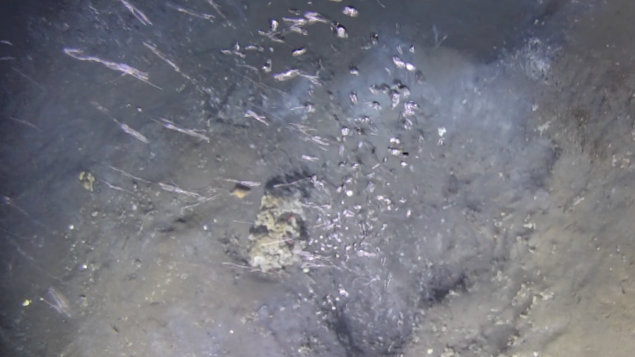A new study from UiT The Arctic University of Norway revealed that estimates of methane emissions released from the Arctic Ocean floor are calculated without taking into account seasonal variability and may therefore be overestimated.
“Because we only go [in the Arctic] during the summer, we usually just multiply whatever comes out [the methane emissions] by 12 to have the yearly rate,” says Bénédicte Ferré, first author of the paper in a phone interview with Eye on the Arctic.
Due to the harsh climate conditions in the Arctic, scientists usually conduct expeditions in the summer and early fall, when the weather and waters are more predictable.
The study published in Nature Geoscience shows that there is far less methane leaking from the Arctic Ocean soil during cold months compared to measurements taken in the summer.
The paper also stresses the importance of correctly estimating methane emissions now in order to better understand how they will evolve in the future and possibly affect climate.
Why is methane so important?
Methane is a powerful greenhouse gas, with a significantly greater global warming potential than carbon dioxide, according to NASA.
“Over a 20-year period, one ton of methane has a global warming potential that is 84 to 87 times greater than carbon dioxide,” says NASA. “Over a century, that warming potential is 28 to 36 times greater.”
According to the Centre for Arctic Gas Hydrate, Environment and Climate (CAGE), which published the study, the atmospheric concentration of methane has almost tripled since the beginning of industrialization. It contributes 16% to the global greenhouse effect and has a lifetime of approximately twelve years in the atmosphere.
Video caption: Gas flare locations in the study area. The yellow dots represent seeps observed during the winter survey, while the red dots represent seeps observed during the summer survey. Methane seeps during the colder season decrease their emissions by 43 percent. (B. Ferré/CAGE, UiT)
The problem is that the origin of this gas is poorly understood by scientists.
“Methane bubbles up from swamps and rivers, belches from volcanoes, rises from wildfires, and seeps from the guts of cows and termites (where is it made by microbes),” says NASA.
In the Arctic, the dangerous gas is meanly leaking out of melting permafrost and the ocean floor.
“When [methane] gets released from the ocean, it can potentially reach the atmosphere.This is the case if we have a stratification that is small enough that we can have a transfer from the sea floor to the surface. And this could potentially affect global warming,” explains Bénédicte Ferré.
Less methane leaks in cold temperatures
Ferré’s team conducted their study west of the Norwegian Arctic Archipelago Svalbard—an area affected by a branch of North Atlantic Ocean current called West Spitzbergen Current.
The observations were made at 400 metres water depth, where the ocean floor is known for its many methane seeps. Scientists used echo flares to detect the gas bubbles which they call “flares”.
The team compared measurements taken in May 2016 to previous ones taken in August 2012.
“In summer, the water is more than 4 °C compared to 1.3 °C in May at the bottom of the ocean,” explains Bénédicte Ferré. “So what we see when the water is much colder is methane emissions reduced by almost half compared to what we usually measure during the summer.”
Video caption: The methane is released as bubbles which can be seen as flares in echo sounder surveys. Here is an example of a marked difference between flares observed in winter (May) and Summer (August). (B. Ferré/CAGE, UiT)
The area where the study was conducted is at the limit of the so-called gas hydrate stability zone. Gas hydrates are solid, icy compounds of water and, often, methane. They remain solid beneath the ocean floor as long as the temperatures are cold and the pressure is high enough, the study says.
“If the pressure decreases and the temperature increases, then the gas hydrates become less and less stable. So when we have a constant moving between stable and unstable conditions, this is when we observe these seasonal variability,” says Ferré.
Seasonal changes also affect methane consuming bacteria
More than 90 percent of the methane released from the ocean floor never reaches the atmosphere.
This is partly due to the physical properties of the ocean itself such as currents and water column stratification, explains the study.
But methane is also consumed by specific bacteria (methanotrophs) in water columns.
“Before, we thought that those bacteria were only dependent on how much methane there is in the water column,” says Bénédicte Ferré. “But there was nothing in the columns in May, which means that there is also a seasonal variability in this microbial activity.”
Before, biogeochemical processes, such as methane oxidation by bacteria, had not been considered to be strongly influenced by seasonal changes. But the results gathered by Ferré’s team proved that this correlation exists.
A warning for the future
The Arctic Ocean is expected to warm between 3 °C and 13 °C in the future, due to climate change.
Although this study does not address future methane emissions, it provides an overview of the current situation and sends a warning.
It highlights the possible impact of a consistently warm bottom water temperature over a 12-month period.
“At 400 metres water depth we are already at the limit of the gas hydrate stability. If these waters warm merely by 1.3 °C this hydrate lid will permanently lift, and the release will be constant,” said Ferré in a press release.
The researcher now hopes that her results will be taken into account in future predictions and that other studies will be conducted during the winter months.








For reasons beyond our control, and for an undetermined period of time, our comment section is now closed. However, our social networks remain open to your contributions.